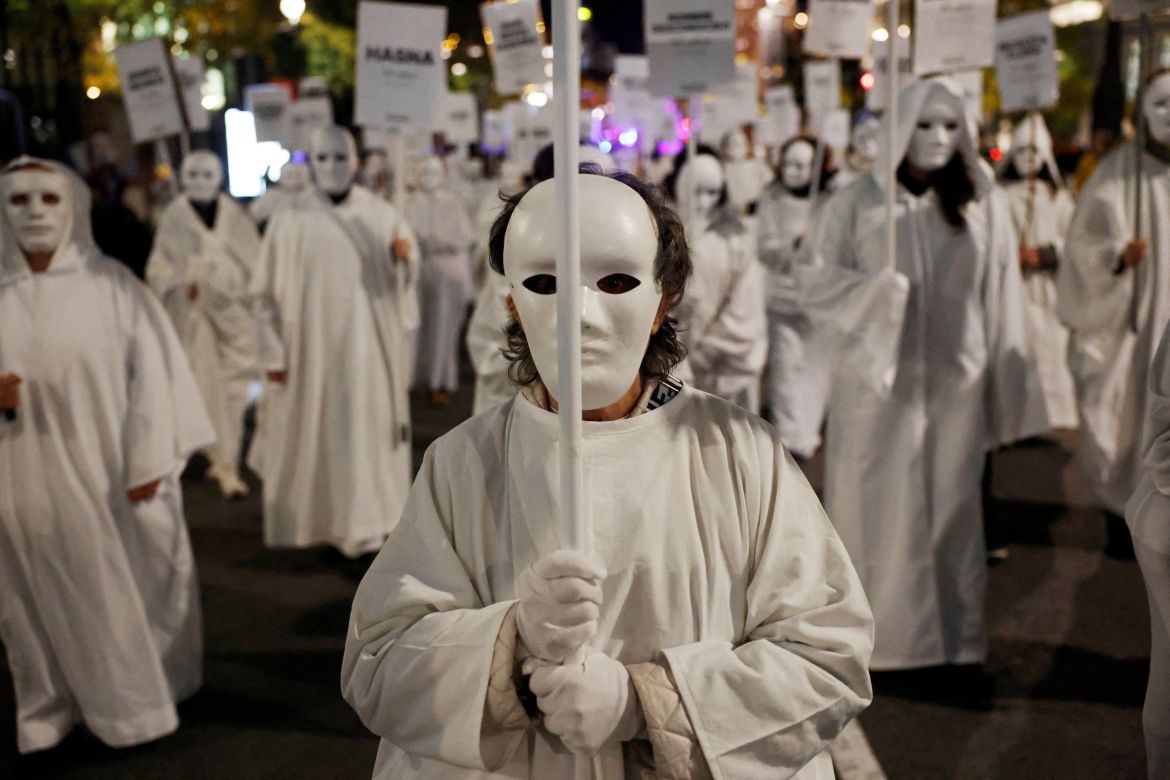In Pictures
Demonstrators hold signs with the names of victims of gender-based violence, during a protest to mark the International Day for the Elimination of Violence against Women, in Madrid, Spain. [Susana Vera/Reuters]Published On 26 Nov 202426 Nov 2024
Tens of thousands of people took to the streets in cities around the world to mark the International Day for the Elimination of Violence Against Women, which was on Monday.
A United Nations report said the deadliest place for women is at home and 140 women and girls on average were killed by an intimate partner or family member each day last year.
Globally, an intimate partner or family member was responsible for the deaths of approximately 51,100 women and girls during 2023, an increase from an estimated 48,800 victims in 2022 that is largely the result of more data being available from countries and not more killings, UN Women and the UN Office of Drugs and Crime said on Monday.
But the two agencies stressed, “Women and girls everywhere continue to be affected by this extreme form of gender-based violence and no region is excluded.”
They said, “the home is the most dangerous place for women and girls”.
According to the report, the highest number of such killings was in Africa – with an estimated 21,700 victims in 2023. Africa also had the highest number of victims relative to the size of its population, at 2.9 victims per 100,000 people, it said.
UN Women’s Deputy Executive Director Nyaradzayi Gumbonzvanda told a news conference while launching the report that women have been killed by their loved ones for a long time and the trend is continuing because underlying issues haven’t been addressed – especially gender stereotyping and social norms.
“This is killing which is associated with power over women,” she said, and it continues because of the continuing impunity for violent attacks against women.
There were high rates last year in the Americas with 1.6 female victims per 100,000 and in Oceania with 1.5 per 100,000, it said. The numbers were significantly lower in Asia at 0.8 victims per 100,000 and Europe at 0.6 per 100,000.
According to the report, the intentional killing of women in the private sphere in Europe and the Americas is largely by intimate partners.
The report said that despite efforts to prevent the killing of women and girls by countries, their killings “remain at alarmingly high levels”.
In contrast, the majority of male homicides take place outside homes and families, it said. “Even though men and boys account for the vast majority of homicide victims, women and girls continue to be disproportionately affected by lethal violence in the private sphere,” the report said.
[Sofia Yanjari/Reuters]As people rally in Caracas, Venezuela, the UN report said “the home is the most dangerous place for women and girls”. [Gaby Oraa/Reuters]People protest to mark the International Day for the Elimination of Violence Against Women, in Mexico City, Mexico. [Toya Sarno Jordan/Reuters]Demonstrators participate in a protest in Quito, Ecuador, as two UN agencies said in a report that 140 women and girls on average were killed by an intimate partner or family member per day last year. [Karen Toro/Reuters]A rally on the International Day for the Elimination of Violence Against Women in Bogota, Colombia. [Luisa Gonzalez/Reuters] Advertisement A demonstrator holds a placard during a protest in Buenos Aires, Argentina. The UN said, “Women and girls everywhere continue to be affected by this extreme form of gender-based violence and no region is excluded.” [Irina Dambrauskas/Reuters]Flanked by riot police, protesters march in Athens, Greece. [Louisa Gouliamaki/Reuters]A banner that reads “Not a single one more” is raised in Sofia, Bulgaria. [Spasiyana Sergieva/Reuters]People are blocked by riot police as they attempt to march to protest against femicide, sexual violence and all gender-based violence in Istanbul, Turkey. [Dilara Senkaya/Reuters]Protesters gather to denounce gender-based violence in Avignon, France. [Alexandre Dimou/Reuters]A placard against femicide, citing 2023 statistics of 180 reported cases across 38 Indonesian provinces, is seen as activists take part in a street protest in Jakarta, Indonesia. [Bay Ismoyo/AFP]
